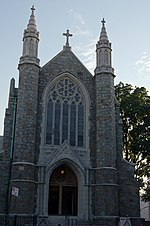Steinway Street

Steinway Street is a major street in the borough of Queens in New York City, New York, in the United States. Steinway Street is a 2.4 mile two-way street that runs north-south between Berrian Boulevard in Astoria and Northern Boulevard in Long Island City. South of the Grand Central Parkway, Steinway Street is a major commercial district that is the primary section of a Business improvement district called Steinway Astoria Partnership.Richard Hellmann, creator of Hellmann's mayonnaise, had his first big factory at 495 / 497 Steinway Street from 1915 to 1922. In 1922, operations moved to a larger factory at 34-08 Northern Boulevard.Steinway Street is accessible by subway at the subway station of the same name (E, M, and R trains). The Q101 bus travels along Steinway Street from 20th Avenue to Northern Boulevard.
Excerpt from the Wikipedia article Steinway Street (License: CC BY-SA 3.0, Authors, Images).Steinway Street
Steinway Street, New York Queens
Geographical coordinates (GPS) Address Nearby Places Show on map
Geographical coordinates (GPS)
| Latitude | Longitude |
|---|---|
| N 40.766716666667 ° | E -73.912688888889 ° |
Address
Steinway Street 25-51A
11103 New York, Queens
New York, United States
Open on Google Maps






